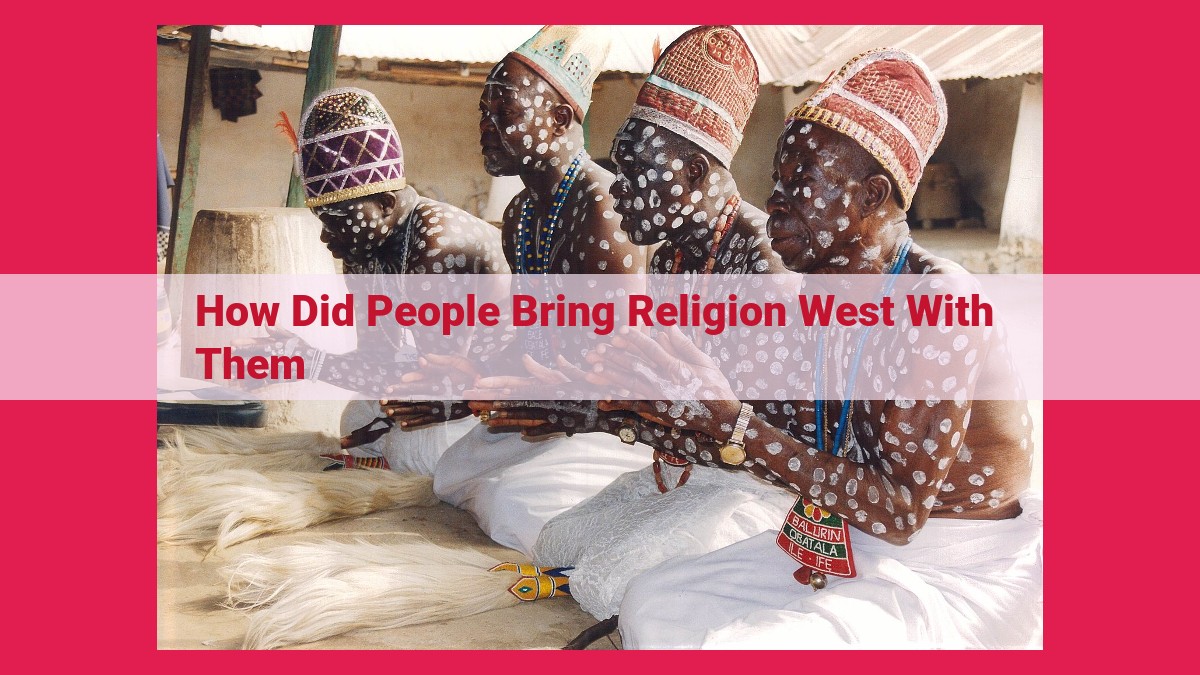The Global Diffusion Of Religion: Spread Through Missions, Colonization, Trade, Immigration, And Cultural Exchange

Religion spread westward through missionary activity, where preachers and institutions converted individuals. Colonization imposed and blended local and introduced beliefs. Merchants and traders carried religious ideas along trade routes. Immigrants brought their religions to new lands, establishing spaces for practice. Cultural exchange allowed for transmission through art and education, such as along the Silk Road.
Missionary Activity: Spreading Faith through Preaching and Institutions
Throughout history, missionaries have played a pivotal role in the spread of religions worldwide. Their tireless efforts have led to the conversion of countless individuals and the establishment of institutions that foster religious continuity.
Missionaries often travel to distant lands with the purpose of preaching about their religious beliefs. They engage in conversations, distribute literature, and conduct religious services to share their message with local communities. Through persuasive arguments and displays of faith, they aim to convert individuals to their religion.
Once new converts are gained, missionaries often work to establish churches and schools. These institutions provide structured environments for religious worship, education, and community building. Churches serve as centers of spiritual growth and support, hosting Sunday services, Bible studies, and other religious activities. Schools established by missionaries offer education that is infused with religious values, shaping the minds of young people and fostering the transmission of religious beliefs from one generation to the next.
The efforts of missionaries have had a profound impact on the global religious landscape. Their preaching and institution building have led to the growth and expansion of religions such as Christianity, Islam, and Buddhism. Moreover, missionaries have played a significant role in the preservation and revival of religious traditions in various parts of the world.
Colonization: Imposing and Blending Beliefs in Conquered Lands
Throughout history, colonization has played a profound role in the dissemination and transformation of religious beliefs. As colonizers ventured into new lands, they carried their faith alongside their ambitions, leaving an enduring mark on the religious landscapes of conquered territories.
Imposition of the Colonizers’ Religions
Colonizers often sought to impose their own religious practices on the indigenous populations they encountered. This could involve the establishment of churches, the introduction of missionaries, and the prohibition of local religious customs. In some cases, this led to violent suppression and the eradication of existing belief systems.
Religious Conversion and Syncretism
However, the imposition of religious beliefs was not always straightforward. In many conquered lands, colonizers encountered strong resistance from local populations. This resistance often resulted in a process of syncretism, where elements of the colonizers’ religion blended with local beliefs and practices.
The process of religious conversion and syncretism was complex and multifaceted. In some cases, local populations voluntarily adopted elements of the colonizers’ religion, seeing it as a source of power or protection. In other cases, conversion was coerced through threats or persecution. Regardless of the methods used, syncretism allowed local beliefs to persist and influence the newly introduced faiths.
Examples of Syncretism
Throughout history, numerous examples of syncretism can be found in colonized lands. In South America, elements of Catholicism blended with indigenous beliefs, resulting in the emergence of unique religious practices such as Santeria and Candomblé. Similarly, in Africa, Christianity and Islam were combined with traditional animistic religions.
Colonization has had a profound impact on the spread and transformation of religious beliefs around the world. The imposition of foreign religions and the subsequent process of syncretism have created a diverse and complex religious landscape. Today, the legacy of colonization continues to shape the way people practice and understand their faith.
Trade: Religious Ideas as Cultural Commodities
Throughout history, trade has played a pivotal role in the dissemination of religious ideas. Merchants and traders, driven by commercial pursuits, have served as inadvertent missionaries, carrying religious artifacts and beliefs along bustling trade routes.
One notable example is the spread of Christianity along the Silk Road, a vast network connecting East and West. Buddhist monks from China embarked on journeys to spread their teachings, establishing monasteries along the route. These monasteries became centers of learning and spirituality, fostering the dissemination of Buddhism westward.
Similarly, Islam gained a foothold in various regions through trade. Muslim merchants from the Middle East and North Africa brought their faith to distant lands, establishing trading communities and mosques. Interactions with local populations led to the conversion of many individuals, gradually expanding the influence of Islam.
The transmission of religious ideas through trade was not limited to large-scale conversions. Merchants and traders often carried personal religious objects, such as amulets or icons. These objects, imbued with religious significance, served as symbols of faith that were exchanged and adopted by those along the trade routes.
Trade not only facilitated the spread of religious beliefs but also contributed to their evolution. As merchant communities interacted with different cultures, they adapted their religious practices, blending local traditions and beliefs with those of their own faith.
This process of syncretism resulted in the emergence of hybrid religious forms, such as the fusion of Hindu and Muslim beliefs in Southeast Asia or the incorporation of Christian elements into indigenous religions in the Americas.
Trade, therefore, played a significant role in shaping the religious landscape of the world. By carrying religious artifacts and ideas along commercial exchanges, merchants and traders became unwitting agents of spiritual transformation, contributing to the spread and evolution of religious beliefs across cultures and continents.
**Immigration: **Establishing Faith in New Homes
As the tapestry of nations unravels and weaves, immigrants play a pivotal role in shaping the religious landscape of their adopted countries. They carry with them cherished beliefs, customs, and a longing to establish a sanctuary for their spiritual expressions.
Upon arriving in unfamiliar lands, immigrants seek solace and connection within faith-based communities. These communities become more than mere gathering places; they transform into vibrant hubs where traditions are preserved and new ones emerge. Within these spaces, immigrants find a sense of belonging, shared values, and a renewed purpose in a foreign land.
Through the collective efforts of immigrant communities, religious institutions flourish. Churches, mosques, temples, and gurdwaras are erected, providing a sanctuary for spiritual growth. These institutions offer not only a place of worship but also a platform for cultural exchange, social services, and educational programs. They serve as beacons of hope and continuity, connecting immigrants to their roots while fostering a sense of belonging in their new home.
As immigrants build their spiritual havens, they also contribute to the religious diversity of their adopted countries. By bringing their unique beliefs and practices, they enrich the tapestry of faith, creating a vibrant and multifaceted spiritual landscape. Immigrants challenge preconceived notions, foster interfaith dialogue, and inspire a greater understanding of the human spirit.
In the stories of immigrant communities, we witness the enduring power of faith. It transcends borders, adapts to new circumstances, and serves as a source of strength and resilience. Through their unwavering devotion, immigrants not only establish faith in their new homes but also contribute to the rich religious heritage of their adopted nations.
Cultural Exchange: A Conduit for Religious Transmission
Throughout history, cultural exchange has served as a vital catalyst for the dissemination of religious ideas. Art, literature, and education have transcended geographical boundaries, facilitating the spread of faiths.
Music has resonated with souls across cultures, conveying spiritual messages through its enchanting melodies. Literature, in its written form, has captured and immortalized religious teachings, making them accessible to generations. Education, as an institution, has played a pivotal role in nurturing and transmitting religious knowledge.
One of the most remarkable examples of cultural exchange in religious transmission is the Silk Road. This ancient trade route connected East and West, fostering the exchange of merchandise, ideas, and beliefs. As merchants traversed its vast expanse, they carried Buddhist scriptures from India to China, and Nestorian Christianity from the Middle East to China.
The Silk Road became a gateway for religious syncretism. Buddhist monks traveled to China, where they adapted their teachings to fit the cultural context of the region. Nestorian Christians in China encountered Daoist and Confucian ideas, blending them with their own beliefs. This mutual exchange of religious concepts resulted in the creation of unique religious traditions, such as Chinese Buddhism and Syncretic Christianity.
Cultural exchange has played a profound role in shaping the religious landscape of the world. Through music, literature, and education, religious ideas have crossed oceans, traversed mountains, and touched the hearts of countless individuals. The Silk Road stands as a testament to the power of cultural exchange in disseminating faith.





